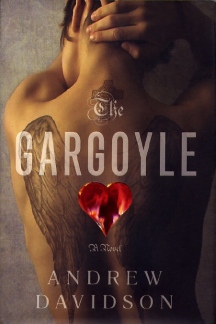Novelists
like to immerse their readers in the narrative, to grab their attention
from the get-go, hoping never to lose hold after a bold beginning. Few
decide to do so by immersing their readers in fire, by rendering third-degree
burns with flinch-worthy veracity. Andrew Davidson isn’t afraid
to do so, and he lingers in his descriptions not just of being burned,
but of the months and indeed years of painful, ugly, partial recovery.
All this, the thirteenth century, even Hell itself, but nary a kitchen
sink in sight. You can describe Andrew Davidson's first novel, 'The
Gargoyle' with a variety of verbs, nouns and adjectives. Just don't
include restrained.
Davidson succeeds easily in his quest to draw readers in as his unnamed
narrator suffers the torments of hell on earth. Before his well-deserved
accident, he was a heartless pornographer, producing and starring in
his own films. Drunk, drugged and driving, he hallucinates a volley
of arrows one night. Swerving to avoid the unreal, he crashes and burns
– both physically and psychologically. In the course of his torturously
detailed recovery, a beautiful woman, Marianne Engel, appoints herself
his caretaker. If this sounds too good to be true, well, it certainly
is. Marianne's a sculptress who fashions hideous gargoyles out of stone,
and she's quite convinced that she knew the narrator in another very
specific life, in 13th century Germany. He thinks she's "unhinged,"
but as she tells him their tale and several others, Scheherazade-style,
Davidson's storytelling skills are brought to the foreground. Clearly
backed by assiduous research, these stories don’t feel like lies,
either emotionally or factually. Marianne doesn't seem unhinged and
her stories seem every bit as true as the present-day story in which
she tells them.
Of course, our narrator has a few other problems. He becomes addicted
to the morphine required to hold back his pain, and has conversations
with a snake that he thinks has replaced his spine. He doesn't buy the
previous-lives line, but who's he to call her crazy? How many sub-stories
can Davidson cram into a single story and still make that single story
compelling? There's clearly more than enough craziness to go around
in 'The Gargoyle', but none to be attributed to the author. He manages
to make a book that seems to go everywhere at least go somewhere, and
that's certainly an entertaining feat.
'The Gargoyle' is an interesting case of literary identity. It includes
history written in the style of fantasy, and fantasies that are clearly
literary. For all the elements of the fantastic you'll find within,
it does not read like genre fiction. Most of the characters are unpleasant
or plainly unlikeable, but they're all interesting to read about. There's
nobody to cheer for in 'The Gargoyle', but you will care about what
happens to those whose lives, real, literary and fantasized, it portrays.
The narrator begins as a heartless SOB, and in the course of the novel
though his skin is imperfectly re-grown, the heart he develops is at
best vestigial. But watching him shiver and sputter as he suffers the
agony he comments upon with archly entertaining self-deprecation is
quite a show. While one might expect a sort of "guardian angel"
like Marianne Engle to compensate with her generosity, she too, is self-involved.
But as she destroys her body and renders her mind to create the grotesque
titular sculptures, she certainly keeps the reader entertained with
her artistic excess. The phrase "made for each other" comes
to mind. Or maybe "deserve one another."
The characters in the stories told by Marianne within the novel fare
a good deal better – at least emotionally. Physically, they tend
to meet fates in line with those of the present day characters. But
at least they try to lead lives of honor, joy, and yes, love. There
are several sub-stories, cleverly woven though the text of the present-day
travails of the crispy pornographer. They're well-written, superbly
researched, emotionally involving and rewarding. Some are short stories,
and a couple of longer pieces are threaded through the novel at greater
length. Some readers might even wonder if what they've got in their
hands is the Evil Father of All Fix-Up Novels, those shambling Frankenstein
beasts stitched from the crumpled bodies of published and unpublished
short stories. There's an element of Frankenstein's monster here in
fact of the stitching. But 'The Gargoyle' doesn't really scan that way.
Given the variety and disparity of elements on display in 'The Gargoyle',
it’s a tribute to the author's skill that it hangs together as
well as it does. At least, it certainly keeps you reading. It's almost
the Rocky Road Ice Cream of novels, with delightful expository lumps
embedded in a chilled slab. But that slab's bitter, black at heart and
not in the least bit sticky. Writing to keep himself entertained, Davidson
manages to entertain and string along the reader as well, with enough
cliffhangers to occupy a battalion of Dudley Do-Wrongs. He knows how
long to let any single story run before pulling the plug. His language
skills are strong if not exactly poetic. He has a firm imagination that
enables him to describe Hell itself as if it were just a bad patch of
town inhabited by a deformed criminal element. It seems real all right,
and our no-so-humble narrator certainly seems at home there.
Keeping it all together is the overarching love story of Marianne and
the narrator. Davidson knows he has to make that story work for the
novel to work as a whole, and it does. But it wouldn't work without
all the Frankenstein stitching. Nor would the stories themselves seem
as notable. Rope 'em all together, get the balance right, and you get
'The Gargoyle'. If you pick it up, you’re unlikely to put it down
or forget it. You might want to punch the narrator. But when he picks
himself up off the ground, bloodied and still garrulous, you'll want
to hear what he has to say.
